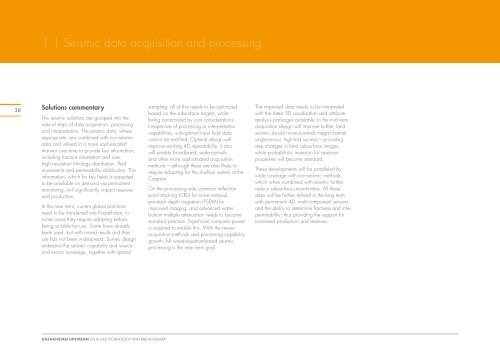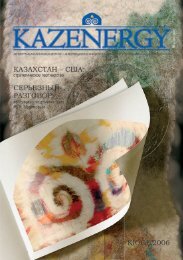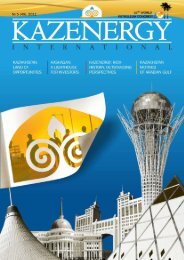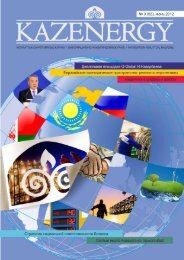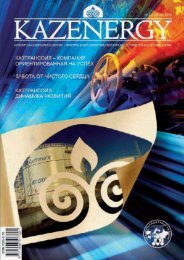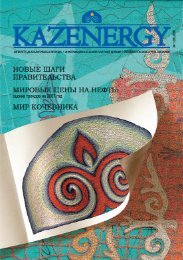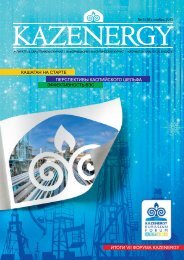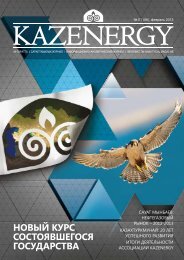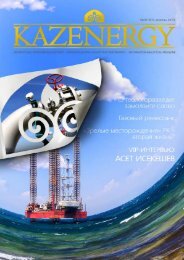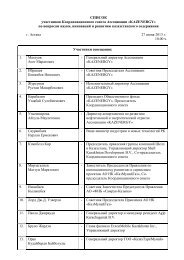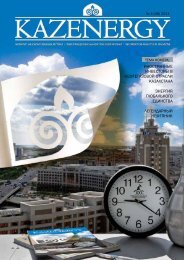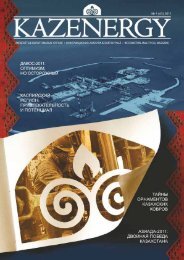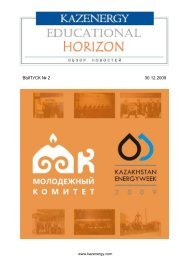KAZAKHSTAN UPSTREAM OIL AND GAS technology and R&d ...
KAZAKHSTAN UPSTREAM OIL AND GAS technology and R&d ...
KAZAKHSTAN UPSTREAM OIL AND GAS technology and R&d ...
You also want an ePaper? Increase the reach of your titles
YUMPU automatically turns print PDFs into web optimized ePapers that Google loves.
1.1 Seismic data acquisition <strong>and</strong> processing<br />
38<br />
Solutions commentary<br />
The seismic solutions are grouped into the<br />
natural steps of data acquisition, processing<br />
<strong>and</strong> interpretation. The seismic data, where<br />
appropriate, are combined with non-seismic<br />
data <strong>and</strong> utilised in a more sophisticated<br />
manner over time to provide key information,<br />
including fracture orientation <strong>and</strong> size,<br />
high resolution lithology distribution, fluid<br />
movements <strong>and</strong> permeability distribution. This<br />
information, which for key fields is expected<br />
to be available on dem<strong>and</strong> via permanent<br />
monitoring, will significantly impact reserves<br />
<strong>and</strong> production.<br />
In the near term, current global practices<br />
need to be transferred into Kazakhstan, in<br />
some cases they require adapting before<br />
being suitable for use. Some have already<br />
been used, but with mixed results <strong>and</strong> their<br />
use has not been widespread. Survey design<br />
underpins the seismic capability <strong>and</strong> source<br />
<strong>and</strong> sensor coverage, together with spatial<br />
sampling; all of this needs to be optimized<br />
based on the subsurface targets, while<br />
being constrained by cost considerations.<br />
Irrespective of processing or interpretation<br />
capabilities, sub-optimal input field data<br />
cannot be rectified. Optimal design will<br />
improve existing 4D repeatability, it also<br />
will enable broadb<strong>and</strong>, wide-azimuth<br />
<strong>and</strong> other more sophisticated acquisition<br />
methods – although these are also likely to<br />
require adapting for the shallow waters of the<br />
Caspian.<br />
On the processing side common reflection<br />
point stacking (CRS) for noise removal,<br />
pre-stack depth migration (PSDM) for<br />
improved imaging, <strong>and</strong> advanced water<br />
bottom multiple attenuation needs to become<br />
st<strong>and</strong>ard practice. Significant computer power<br />
is required to enable this. With the newer<br />
acquisition methods <strong>and</strong> processing capability<br />
growth, full wave-equation-based seismic<br />
processing is the near term goal.<br />
The improved data needs to be interpreted<br />
with the latest 3D visualisation <strong>and</strong> attribute<br />
analysis packages available. In the mid term,<br />
acquisition design will improve further, l<strong>and</strong><br />
seismic should move towards mega-channel,<br />
single-sensor, high-fold surveys – providing<br />
step changes in l<strong>and</strong> subsurface images,<br />
while probabilistic inversion for reservoir<br />
properties will become st<strong>and</strong>ard.<br />
These developments will be paralleled by<br />
wide coverage with non-seismic methods,<br />
which when combined with seismic further<br />
reduce subsurface uncertainties. All these<br />
steps will be further refined in the long term<br />
with permanent 4D, multi-component sensors<br />
<strong>and</strong> the ability to determine fractures <strong>and</strong> infer<br />
permeability; thus providing the support for<br />
increased production <strong>and</strong> reserves.<br />
Kazakhstan Upstream oil & gas <strong>technology</strong> <strong>and</strong> R&D roadmap


